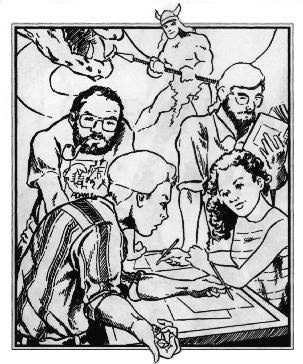

Narrative or Tabletop Role-playing Games are a large class of commercially-available games. These are usually available only at specialized hobby or game stores, although a few (such as Dungeons & Dragons) can be found in regular bookstores. "Narrative" means to that game actions are taken primarily through verbal declaration (i.e. "my character climbs the wall"). These are also known as "tabletop" RPGs (to distinguish them from live-action roleplaying) or "paper-and-pencil" RPGs (to distinguish them from computer games).
Narrative role-playing games are played sitting around in a comfortable setting (often around a table but not neccessarily), and what happens is defined by verbal description. i.e. A player simply declares "I am walking to the window", and it is understood that her character is doing just that. Diagrams and notes may be used as aids, but narration is the primary medium. These are often referred to as "tabletop" RPGs (to distinguish them from "live action" RPGs where the players move around) or "paper-and-pencil" RPGs (to distinguish them from computer games).
There is a wide variety of these games, but they have common features. One person generally acts as the Game Moderator or Game Master (abbreviated GM), who is the authority on the fictional setting (aka "game-world"), and has final say over what happens. A typical game session has the GM prepare a set of challenges for the players in advance. Each player (except the GM) has a single character in the game-world which he controls (known as a player-character or PC). The players then declare what their PC's try to do, and the GM describes what happens.
In practice, much of what happens is either descriptive or obvious results: i.e.
Player: I carefully walk up to the window and look inside. What do I see?
GM: [checks notes] You see a dusty room with a table in the center, which has a wooden box on it. The walls are bare, but there's a door to the inside. Player: Alright, I'm taking my knife and scratching a mark on this window, so the others can identify it later. GM: OK - done. [scribbles this on his notes]
Note that the player uses the first person ("I") to describe what her character is doing. This is just a common way of speaking. Some players use their character's name instead (i.e. "Davidson walks up to the window"). Of course, at other times the results are less clear. For example, the same setup could have more complicated results:
Player: I carefully walk up to the window and look inside.
GM: You see a room with a table in the center. There's a man sitting at the table playing solitaire. He has a revolver sitting on the table beside the cards.
Player: Yikes! I duck down, as quietly as possible. Did it look like he saw me?
This is the basic case of "action resolution" -- ...
It is a bit like cooperative storytelling -- by announcing and describing to the other players what you are doing, you become part of the ongoing story.
Table-top roleplaying was first popularized by the game (Advanced) Dungeons & Dragons, and that remains the dominant game on the market. However, there is an enormous variety of other games available now. For an overview, I have an encyclopedia of most published RPGs games with capsule descriptions.
In general, published RPGs tend to be fantasy or science-fiction oriented, although there are many exceptions.
Well, regular players each have characters under their control, called player characters or PC's.
Meanwhile, one person acts as organizer and controller of the action, known as the game-master or GM (there are many other terms, but `GM' is the most widely used). The GM is responsible for describing the story's setting, including all of the characters which do not have an associated player (called non-player characters or NPC's.)
For example, if the PC's are a group of detectives, the GM might prepare details of a crime they have to solve, and control what the culprit does and says. For more information, I have a few sources:
Usually everyone has a set of notes on their part of the game, and they use a published a set of rules to help resolve certain actions. That is, each player will have a character sheet, which define what the character can do, in terms of the rules system. The rules might define how much a character can lift, or what his chances are of climbing a cliff, and so forth.